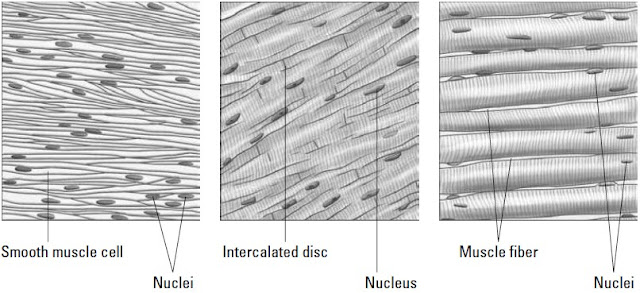The skull is made up of 19 bones, 12 of which are pairs. You
can see most of these bones in the illustration. Where the
bones join is called a suture. Little fingers of bone interdigitate
with adjoining little fingers to make the joining solid.
The bones shown are: the frontal bone, the nasal bones, the
lacrimal bones, the ethmoid bones, the sphenoid bones, the
zygomatic bones, the maxilla, the mandible, the parietal
bones, the temporal bones, the occipital bone, the palatine
bones (not seen, since they are inside the orbit of the eye),
and the vomer (not seen, since it is inside the nasal cavity).
There are two bones that you cannot see in the illustration,
the palatine and the vomer. The palatine bones are paired
and are buried deep in the skull behind the nose. They make
up the rear part of the palate, part of the base of the nasal
cavity, and a small part of the floor or the orbit. The vomer is
a thin bone which forms part of the nasal septum separating
the two sides of the nasal cavity.
Lacrimal, meaning tear producing, is from the Latin lachrymal,
meaning a small vase, of the kind found in ancient
Roman sepulchers that was used for collecting tears shed in
mourning.(The lacrimal bone forms half of the receptacle,
which holds the lacrimal sac, a structure that receives the
tears and directs them into the nasal cavity. That explains
why we blow our noses in cold weather, or when we cry, we
are blowing out the tears that have drained into the cavity.
The other half of the receptacle for the lacrimal sac is made
from the frontal process of the maxilla.) Ethmoid, so-named
because it is full of holes, is from the Greek ethmo and oiedes,
meaning “formed like a strainer.” Sphenoid is from the Greek
spheno and eidos together meaning wedge-shaped. Zygomatic
or zygoma comes from the Greek zygon, which means yoke,
the kind used to harness oxen. Maxilla is from the Latin mala
meaning jaw, particularly the upper jaw. Mandible derives
from the Latin mandibula, which stems from mandare meaning
to chew and pertains particularly to the lower jaw, which
has most of the chewing motion. Parietal is from the Latin
paries, parietes, meaning “walls of a hollow cavity.” Temporal
indicates the temple, from the Latin tempora, meaning “temple,
the right place, the fatal spot..”(As well as indicating a
place on the skull where death can easily be afflicted, this
word coveys a sense of reverence for life.) Occipital is from
the Latin occiput, meaning “the back of the head.” Palatine is
from the Latin palatum, meaning the hard palate and is the
base for the words palatable and palliative. Vomer is the Latin
word for plowshare.
Search term
Human anatomy of head and neck
can see most of these bones in the illustration. Where the
bones join is called a suture. Little fingers of bone interdigitate
with adjoining little fingers to make the joining solid.
The bones shown are: the frontal bone, the nasal bones, the
lacrimal bones, the ethmoid bones, the sphenoid bones, the
zygomatic bones, the maxilla, the mandible, the parietal
bones, the temporal bones, the occipital bone, the palatine
bones (not seen, since they are inside the orbit of the eye),
and the vomer (not seen, since it is inside the nasal cavity).
There are two bones that you cannot see in the illustration,
the palatine and the vomer. The palatine bones are paired
and are buried deep in the skull behind the nose. They make
up the rear part of the palate, part of the base of the nasal
cavity, and a small part of the floor or the orbit. The vomer is
a thin bone which forms part of the nasal septum separating
the two sides of the nasal cavity.
Lacrimal, meaning tear producing, is from the Latin lachrymal,
meaning a small vase, of the kind found in ancient
Roman sepulchers that was used for collecting tears shed in
mourning.(The lacrimal bone forms half of the receptacle,
which holds the lacrimal sac, a structure that receives the
tears and directs them into the nasal cavity. That explains
why we blow our noses in cold weather, or when we cry, we
are blowing out the tears that have drained into the cavity.
The other half of the receptacle for the lacrimal sac is made
from the frontal process of the maxilla.) Ethmoid, so-named
because it is full of holes, is from the Greek ethmo and oiedes,
meaning “formed like a strainer.” Sphenoid is from the Greek
spheno and eidos together meaning wedge-shaped. Zygomatic
or zygoma comes from the Greek zygon, which means yoke,
the kind used to harness oxen. Maxilla is from the Latin mala
meaning jaw, particularly the upper jaw. Mandible derives
from the Latin mandibula, which stems from mandare meaning
to chew and pertains particularly to the lower jaw, which
has most of the chewing motion. Parietal is from the Latin
paries, parietes, meaning “walls of a hollow cavity.” Temporal
indicates the temple, from the Latin tempora, meaning “temple,
the right place, the fatal spot..”(As well as indicating a
place on the skull where death can easily be afflicted, this
word coveys a sense of reverence for life.) Occipital is from
the Latin occiput, meaning “the back of the head.” Palatine is
from the Latin palatum, meaning the hard palate and is the
base for the words palatable and palliative. Vomer is the Latin
word for plowshare.
Search term
Human anatomy of head and neck





